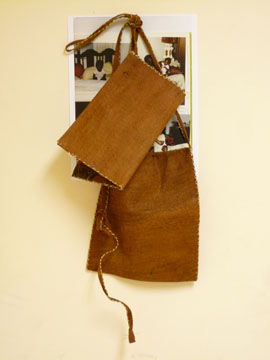
Paul Mpagi Sepuya, "As-yet-untitled work," 2009. Photograph, Ugandan bark-cloth bags, screw. Courtesy the Artist.
I met the artist Paul Mpagi Sepya when he worked at Creative Capital a couple of years back. I’ve followed his thoughtful, evocative, and beautiful photo portrait work ever since.
Last week, I got to check out his latest series, which is part of Homebase IV, an installation of work by an international array of artists in a former nursing and rehabilitation center on the Lower East Side in New York City.
Though his father is Ugandan, Paul grew up in San Bernadino, CA and has never visited Uganda. For this series, he photographed friends who have been to Kampala and objects they brought back from those visits. Following is the entirety of an email interview I conducted with Paul about his Homebase project.
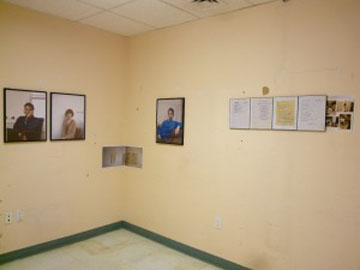
Paul Mpagi Sepuya, "Homebase" project, installation view, 2009. Courtesy the Artist.
Kemi Ilesanmi: How did this year’s current “Homebase” location in a former medical facility help inspire this project? How did you work with this very particular historical, aesthetic, and psychic context?
Paul Mpagi Sepuya: The location was a definite catalyst in me thinking about home in this way. With both parents being in medicine, I spent a lot of time hanging out after school or volunteering as a kid in hospitals. My mom was big on that. There was a lot of sensory memory there. The space itself had a lot of content that I was not sure how directly to address at first. I began thinking of my idea of ‘home’ related to migration and stories because I imagine the medical profession is what set off my father’s journey that led to his children’s (and my own) peculiar relationship to Uganda.
Aesthetically, the building presented its own challenge. It is totally gutted! Hospitals are uncomfortable enough for a lot of people, and to walk into a medical center in New York City in that state made it even more so. But I thought it was very interesting that those conditions are often romanticized by western travelers who go to developing countries. It suggested a connection, I thought, between ‘here’ and ‘there.’ So I left my space as it was.
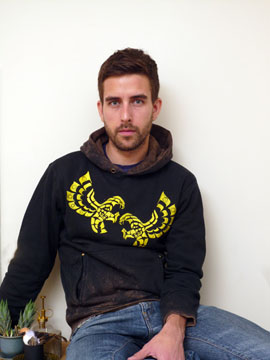
Paul Mpagi Sepuya, "Jonathon, Brooklyn, NY," 2009. Courtesy the Artist.
KI: Since you usually work with subjects whom you already know and share a narrative with, I couldn’t help but wonder at the stories that passed between you and the sitters. Yet, I felt locked outside a certain knowledge even as I was intrigued by the rich exchanges that I imagined. Is that kind of tension between knowing and looking an important part of the portrait for you?
PMS: Yes! I’m really into establishing the foundational knowledge of a connection/narrative, but positioning it so that the content of that narrative is a private exchange. In a sense it’s my hope that those details are not important to the viewer’s experience, because I’m not spelling out the story but making projects that suggest how a narrative itself can work. Within that there is a lot of space for the viewer to fill in his own content—to imagine! To think about their own experiences that may relate.
That made this project somewhat difficult for me. Although all my projects are informed by my life, I have never made an autobiographical work that reveals the underlying stories… The difference between a memory, a portrait, a resolution, and even the Proofs projects only suggest at the stories behind them. Now I’m actually putting up family snapshots!
KI: I love the juxtaposition of the formal portraits of friends with the casual family snapshots. For me, it also highlighted the starkly different journeys on display: on the one hand, Americans headed to Uganda, perhaps for adventure or Peace Corps stints, and on the other, your father making his way across continents for a better life, the American Dream, or thereabouts.
PMS: The snapshots are of me as a baby. The portraits of me with my father in the red living room are at my mom’s parent’s house in Louisiana. It is a contrast in journeys, and the idea of ‘formative experiences.’ I like the tension given to the idea of how one’s experience is valued. What kind of journey, and how long must you go to claim an authentic experience?
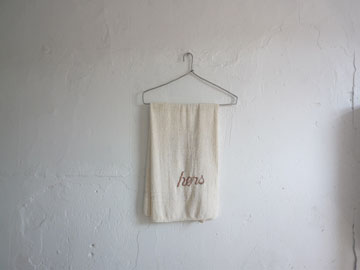
Paul Mpagi Sepuya, "Hers," 2009. Courtesy the Artist.
KI: You also included images of objects that the sitters brought back from Uganda, right? And in one case, you display actual bark-cloth bags from there. What do those objects tell you?
PMS: I did include several photographs of objects that they brought back, now part of their home lives. My favorites are the handmade clothes hangers. The bark-cloth bags are little bags for school children brought for my brother and me by our grandmother. They were the one thing that we managed to hold on to after many other objects were lost.
KI: Did you grow up with Ugandan objects around the house? Food? Stories from Dad or relatives? The role of storytelling and objects as a construction of place, history, and connection is always fascinating.
PMS: There were so many things! We were taught Luganda, and had family visiting. We were especially close to our cousin Jane who lived with us for a while. I remember she would tell us stories, make sure we kept up our language lessons and would come see my brother and me in our little tae kwon do tournaments. But then she was sent away, along with all of our other tangible connections. I don’t know how I would find her now.
KI: When, if ever, does Uganda feel like home to you?
PMS: It’s like a messy inheritance. Something beautiful, but I don’t know how to handle it. I acknowledge it and cherish knowing that it’s there but at the same time it’s embarrassing to know how little I really hold of it. Sometimes it feels like maybe I made it all up.

Paul Mpagi Sepuya, "Letters," mixed media, 2009. Courtesy the Artist.
KI: How did you come across the student surveys that are also on display? Was it just by chance that everyone wants to be a doctor or a nurse? When I was growing up in Nigeria, the only acceptable career paths were doctor or pharmacist (if you were good at the sciences) or laywer (if you weren’t)…I was on the lawyer path, alas!
PMS: Patrick briefly taught an English language class and the papers are some of the homework assignments I culled. I specifically chose those four who wanted to be doctors and nurses. As I imagine, any of those children could be set off along the same future journey as my father and countless other immigrants. The title of that piece is Four Letters (Who will bring our children home?). Doctor was the only acceptable career choice for all of my siblings and me. Again, this messy inheritance handed to you, and how do you accept or reject it?
KI: Have you ever tried to visit Uganda? Any desire or plans to do so?
PMS: I have never tried to visit Uganda, but I will one day. I have to.
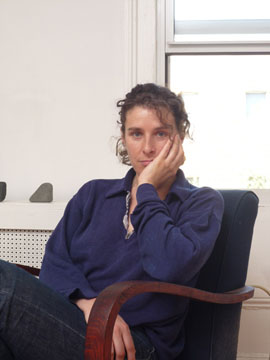
Paul Mpagi Sepuya, "Zoe," 2009. Courtesy the Artist.
KI: Is this an ongoing series?
PMS: I don’t know yet. The portraits as a concept have been on my mind for a while, but this installation is very specific to the Homebase project and it’s unique content and challenges. I could see it growing in the same way as the somewhat-related Family Portraits series has been. We’ll see!
KI: Thank you, Paul!
HomeBase IV is open noon to 8 p.m. Wednesday to Sunday, through May 24, at 232 East Broadway, at Clinton Street, Lower East Side; (646) 957-7165, www.homebaseproject.com.



